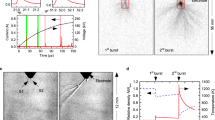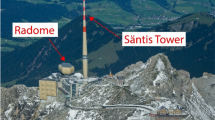Abstract
THE development of the spark discharge has been studied with the aid of the rotating camera1,2,3 in a manner similar to Schonland‘s studies of the lightning discharge, and the leader-stroke mechanism which he first described has been shown to precede in similar manner the main spark discharge in air at atmospheric pressure. Schonland4 suspected that the stepped leader discharge was not advancing into wholly un-ionized or virgin air, and suggested that it travelled along a pre-existing ionized path, the path of a ‘pilot streamer', which probably moved from cloud to ground with the effective velocity of the stepped leader process, say, 107 cm./sec. He failed to record this pilot streamer—if it exists—photographically.
This is a preview of subscription content, access via your institution
Access options
Subscribe to this journal
Receive 51 print issues and online access
$199.00 per year
only $3.90 per issue
Buy this article
- Purchase on Springer Link
- Instant access to full article PDF
Prices may be subject to local taxes which are calculated during checkout
Similar content being viewed by others
References
Allibone and Schonland, Nature, 134, 736 (1934).
Allibone, J. Ind. Elect. Eng., 82, 513 (1938).
Allibone and Meek, Proc. Roy. Soc., 166, 97 (1938).
Schonland‘s most recent review, Proc. Phys. Soc., 55, 445 (1943).
Bruce, C. E. R., Proc. Roy. Soc., 183, 228 (1945).
Schonland and Allibone, Nature, 128, 794 (1931).
Author information
Authors and Affiliations
Rights and permissions
About this article
Cite this article
ALLIBONE, T. Development of the Spark Discharge. Nature 161, 970–971 (1948). https://doi.org/10.1038/161970a0
Issue Date:
DOI: https://doi.org/10.1038/161970a0
This article is cited by
-
Electrical and Optical Characteristics of D.C. Corona Discharge
Nature (1951)
-
Pre-Breakdown Discharges in D.C. Positive Point to Plane Corona
Nature (1951)
-
Lightning and Spark Phenomena
Nature (1949)
-
Letters to Editor
Nature (1948)
-
Development of Spark Discharges
Nature (1948)
Comments
By submitting a comment you agree to abide by our Terms and Community Guidelines. If you find something abusive or that does not comply with our terms or guidelines please flag it as inappropriate.



